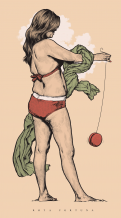| Zeitschrift Umělec 2001/1 >> Scott`s film column | Übersicht aller Ausgaben | ||||||||||||
|
|||||||||||||
Scott`s film columnZeitschrift Umělec 2001/101.01.2001 Scott MacMillan | neuigkeiten | en cs |
|||||||||||||
|
That Frankenstein has a place in the canon of modern thought is unquestionable. Repeated reshaping since its creation by Mary Shelley in 1816 has transformed this tale of “man playing god” into little more than a recurring pop motif — albeit one fraught with racial, sexual and political undertones, and one that invariably attempts to evoke the alienation of modern life. Today, scientific discussions of artificial intelligence and genetics assume moral and often religious tones haunted by the specter of Frankenstein — the sentient undead, or that which crosses the line between being and non-being.
Perhaps more of a central “Frankenstein” text than Shelley’s book itself is the 1935 film The Bride of Frankenstein, made by Universal Pictures, directed by James Whale, and starring Boris Karloff as the Creature. A sequel to the first Frankenstein, made four years earlier, this film was strongly influenced by German Expressionism and is often considered the best of the Frankenstein movies — “a sly, subversive work that smuggled shocking material past the censors by disguising it in the trappings of horror,” says critic Roger Ebert. Dr. Septimus Pretorius lures Dr. Frankenstein away from the comforts of domesticity back to the laboratory, where he shows him his own versions of Frankenstein’s life-creating experiments. The viewer is treated to a bizarre sequence wherein Lilliputian figures of King, Queen, Bishop and Devil come alive and prance about on Pretorius’ table. Rather than bring the dead back to life, as Frankenstein did, Pretorius explains that he has grown his creations from seeds. This is, it would appear, one of the first filmic reference to the then-nascent science of genetics, with obvious racial overtones: Pretorius wishes to become the progenitor of a “man-made race upon the earth.” Pretorius, arch and diabolical, toasts his collaboration with Frankenstein: “To a new world of gods and monsters.” Many have pointed to the theme of sexual subversion that runs throughout in Bride of Frankenstein. Critic Gary Morris, for instance, unequivocally states that Whale’s masterpiece is a veiled gay critique of heterosexual values. (The 1998 film Gods and Monsters portrays the last years of Whale, who was openly gay, in a similar vein.) Yet the film is far more than a gay parable. Unlike in their first film, in which the creature was but a speechless brute, Whale and Karloff give the Monster human qualities using strange, halting dialogue and a sorrowful array of facial expressions. (It is worth noting that in Shelley’s original, the Creature reads Goethe, Milton and Plutarch.) For nearly 20 years following Bride, a slew of American movies established Frankenstein firmly as modern folklore. But few had any artistic merit. In the 1960s, British movie studio Hammer picked up where Universal left off. Hammer’s series of schlock Frankenstein films had little to do with Shelley’s original novel, yet they were hugely influential: unapologetic gore, subtexts of sexual Puritanism, and hints of Cold War paranoia gave rise to the modern slasher film, a genre that peaked in the late 1970s with American films such as Halloween and Friday the 13th. Notable in nearly all post-Bride renderings is the confusion of creature with creator. Indeed, the very title of Bride itself is misleading, since the subject of the film is not in fact the bride of Frankenstein himself, but the Bride of his creation, the Creature. In the Hammer movies, the Creature often plays a secondary role, the primary evil being located in the character of Frankenstein, portrayed by the late Peter Cushing, whose portrayal gained him notoriety as the quintessential “mad scientist,” quietly devising plots to destroy the human race. (To moviegoers raised on later Hollywood fare, Cushing is best known as Grand Moff Tarkin, Darth Vader’s boss in 1977’s Star Wars.) Contemporary Frankenstein readings such as Kenneth Branagh’s (1994) have returned to the romantic posturing of the beast’s creator and the intentions of Shelley herself (wife of poet Percy Bysshe Shelley and friend of Lord Byron). Branagh’s version, co-starring Robert de Niro as the Creature, is marked by numerous self-renderings of Branagh as the bare-torsoed Byronic hero, struggling with obsession and struck by a love powerful enough to overcome death itself. Despite its resolute mediocrity, Branagh locates the Frankenstein drama firmly in the Romantic tradition. Branagh also breaks new ground in his portrayal of the Monster’s genesis, which is a delightful and revolting mixture of organic and inorganic elements, with electric eels squirming in amniotic fluid (details not included in the original novel) zapping the Creature back to life. Meanwhile, De Niro’s portrayal of the Creature highlights a fear of psychic fragmentation: The composition of the Monster from parts of dead criminals — “evil stitched to evil” — is an Oedipal threat to wholeness that provides one of the bases of modern horror. In fact, these films are part of a larger cinematic tradition that raises the issue of human identity in the age of science, a tradition that collectively can be labeled “the Frankenstein films.” Many are classified as science fiction. An obvious specimen is Ridley Scott’s Blade Runner (1982). In all these films — 1987’s Robocop is another — the stated aim of the Creature(s) is to kill the man responsible for bringing them into this world. Invariably, Frankenstein films overlap with the sub-genre of science fiction dealing with artificial intelligence. In these stories, man typically creates a machine that can think like a human — a callous machine that ultimately, like the Creature, turns on its creators. The prototype for this portrayal of artificial intelligence is the ship computer Hal from 2001: A Space Odyssey (1968). But where Stanley Kubrick’s masterpiece uses cool understatement in its depiction of the sentient machine, 1977’s Demon Seed follows its thematic lead but employs the extreme portrayals so typical of the horror genre. The diabolical Creature is a computer named Proteus, a super-computer that achieves a level of functioning allowing it to question and disobey its human masters. Proteus’ ultimate desire is to mate and create a progeny, and in a bizarre and unparalleled scene, the computer physically rapes the star of the film, Julie Christie, impregnating her with an embryo that gestates at an accelerated level in the womb before removal to the machine’s mechanical incubator. The “creation scene” does not take place until the end, when the child is born in an unsettling mélange of flesh and metal. Few recent films have dealt successfully with the intersection of the Frankenstein myth and real-world developments in science, such as the publication of the human genome map. The theme crops up now and again in Hollywood movies, for better and for worse. Two movies in 1997, Alien: Resurrection and Gattaca, explicitly dealt with genetics, as did the instantly forgettable Schwarzenegger flic from last year, The Sixth Day. But these are not really Frankenstein films. A movie slated for release later this year promises to rehash Kubrick’s fascination with artificial intelligence. The late filmmaker had been involved in a project called A.I. – Artificial Intelligence, a movie eventually directed by Steven Spielberg (apparently chosen by Kubrick himself before his death last year) and starring Haley Joel Osment (of Sixth Sense fame) and Jude Law as two self-aware androids obsessed with what we might call “the human question.” Whether this big-budget motion picture will break new ground in the modern Frankenstein fable remains to be seen.
01.01.2001
Empfohlene Artikel
|
|||||||||||||
|
04.02.2020 10:17
Letošní 50. ročník Art Basel přilákal celkem 93 000 návštěvníků a sběratelů z 80 zemí světa. 290 prémiových galerií představilo umělecká díla od počátku 20. století až po současnost. Hlavní sektor přehlídky, tradičně v prvním patře výstavního prostoru, představil 232 předních galerií z celého světa nabízející umění nejvyšší kvality. Veletrh ukázal vzestupný trend prodeje prostřednictvím galerií jak soukromým sbírkám, tak i institucím. Kromě hlavního veletrhu stály za návštěvu i ty přidružené: Volta, Liste a Photo Basel, k tomu doprovodné programy a výstavy v místních institucích, které kvalitou daleko přesahují hranice města tj. Kunsthalle Basel, Kunstmuseum, Tinguely muzeum nebo Fondation Beyeler.
|






























 New book by I.M.Jirous in English at our online bookshop.
New book by I.M.Jirous in English at our online bookshop.
Kommentar
Der Artikel ist bisher nicht kommentiert wordenNeuen Kommentar einfügen